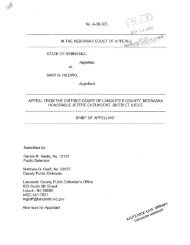Financial Articulation of a Fiduciary Duty to Bondholders with ...
Financial Articulation of a Fiduciary Duty to Bondholders with ...
Financial Articulation of a Fiduciary Duty to Bondholders with ...
Create successful ePaper yourself
Turn your PDF publications into a flip-book with our unique Google optimized e-Paper software.
1986] FIDUCIARY DUTY TO BONDHOLDERS<br />
only Contractual Credi<strong>to</strong>rs' argument is logically congruent <strong>with</strong> the<br />
applicable theoretical structure <strong>of</strong> corporate finance, Contractual<br />
Credi<strong>to</strong>rs state the fair position from the viewpoint <strong>of</strong> corporate finance.<br />
The new fiduciary articulation is fair <strong>to</strong> all classes <strong>of</strong> the corporation's<br />
securityholders because it compels efficient use <strong>of</strong><br />
corporate assets <strong>with</strong> side payments so as <strong>to</strong> maximize gains and minimize<br />
losses for all such classes.<br />
The "transactions-costs view" 194 that a managerial fiduciary duty<br />
<strong>to</strong> bondholders should be created on the ground <strong>of</strong> the costs involved<br />
in contracting for bond protective contractual provisions and <strong>with</strong>out<br />
the foundation <strong>of</strong> a bondholder-management fiduciary relation' 95<br />
seems <strong>to</strong> be in error because: (1) the transactions costs aspect <strong>of</strong> the<br />
fiduciary formula cannot impose duties (obligations) <strong>with</strong>out the<br />
foundation <strong>of</strong> a fiduciary relation, 196 and (2) such transactions costs<br />
and their bond protective contractual provisions become irrelevant<br />
through bond pricing in the efficient capital market fully reflecting<br />
the extent <strong>to</strong> which bond protective contractual provisions are less<br />
than perfect or do not exist. 197 Furthermore, the transactions-cost<br />
view cannot solve the problem <strong>of</strong> the transformation <strong>of</strong> perfect ex<br />
ante contractual specificities in bond pricing in<strong>to</strong> imperfect ex post<br />
contractual specificities' 98 because: (1) a fully protected contract (in<br />
194. The transactions-costs view should not be confused <strong>with</strong> the costly-contracting<br />
hypothesis. The bond-pricing issue <strong>of</strong> inherent ex post unanticipated wealth expropriations,<br />
see supra text accompanying note 45; Smith, Jr. & Warner, supra note 39, at<br />
119 n.5, is separable from views "about whether the <strong>to</strong>tal value <strong>of</strong> the firm is influenced<br />
by the way in which the bondholder-s<strong>to</strong>ckholder conflict is controlled." Id. at<br />
119. The "costly contracting hypothesis" states "that control <strong>of</strong> the bondholder-s<strong>to</strong>ckholder<br />
conflict through financial contracting can increase the value <strong>of</strong> the firm," id at<br />
121, whereas the "irrelevance hypothesis" states that control <strong>of</strong> "the bondholder-s<strong>to</strong>ckholder<br />
conflict does not change the value <strong>of</strong> the firm." Id. at 120. The evidence supports<br />
the costly-contracting hypothesis. Id at 153. This means that economic fac<strong>to</strong>rs<br />
"are insufficient <strong>to</strong> induce the s<strong>to</strong>ckholders <strong>to</strong> maximize the value <strong>of</strong> the firm rather<br />
than maximizing the value <strong>of</strong> the equity." Id at 121. The factual dominance <strong>of</strong> the<br />
costly-contracting hypothesis is <strong>to</strong> be expected because the unrestricted capital market<br />
takeover mechanism, supra note 21 and accompanying text, supporting the irrelevance<br />
hypothesis when corporate investment policy is not fixed, see Smith, Jr. & Warner,<br />
supra note 39, at 120, is neutralized by our corporate law's policy <strong>of</strong> permissive managerial<br />
resistance <strong>to</strong> takeovers. See supra text accompanying notes 176-77.<br />
195. See McDaniel, supra note 71, at 447, 456.<br />
196. See supra note 173 and accompanying text. See also SEC v. Chenery Corp.,<br />
318 U.S. 80, 85-86 (1943) (stating that fiduciary status precedes content definition<br />
<strong>with</strong>in that status). Thus, notions about "efficient" or "optimal" fiduciary duties, Mc-<br />
Daniel, supra note 71, at 447 & nn.176-78, seem <strong>to</strong> have no meaning in the absence <strong>of</strong> a<br />
fiduciary relation which is the foundation for such fiduciary duties.<br />
197. See supra notes 28, 43-44 and accompanying text. Cf AM. BAR FOUND., supra<br />
note 6, at 13 (stating: "Of great importance, <strong>of</strong> course, is the relationship between the<br />
strength <strong>of</strong> the covenants and the other negotiated terms, including the interest<br />
rate.").<br />
198. See supra text accompanying note 45.








